Robin Dluzen is a whirlwind of energy. Since landing in Chicago, Dluzen has established a healthy art practice, curated a number of insightful exhibitions, and written regularly on the city’s visual arts. This week the COMP Magazine trekked up to Avondale to discuss with Dluzen the role family plays in her art practice, the exhibition, Lions: Founding Years of UIMA in Chicago, she co-curated with Stanislav Grezdo at the Ukrainian Institute of Modern Art (UIMA), her passion for boxing, her role as a critic, and how these various aesthetic pursuits converge.
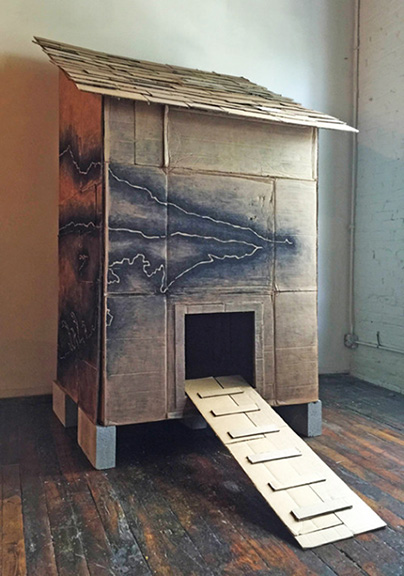
Robin Dluzen
Ameraucana
2016
Cardboard, charcoal, concrete, wire mesh, mason jars and egg shells
84″ x 48″ x 40″
You grew up in a creative family. Your mother produces botanical illustrations and your father fabricates uniquely American handmade furniture. Having grown up in Michigan in this type of environment your aesthetic interests appear rooted in the Midwest. Beyond the intimacy and accessibility one finds in Chicago, what do you see is distinctively unique to the Windy City in contrast to other art centers (NYC, L.A.) located on the coasts? Why is staying here of importance?
Chicago is unique in that our rather modest art market (compared to NY and LA) alleviates the emphasis on artists creating salable work, resulting in art that is riskier, and in social practice, installation and durational work that is so much more exciting to me as a maker, critic and curator. I’d much rather be creating in this kind of environment than one with a dialogue centered around money.
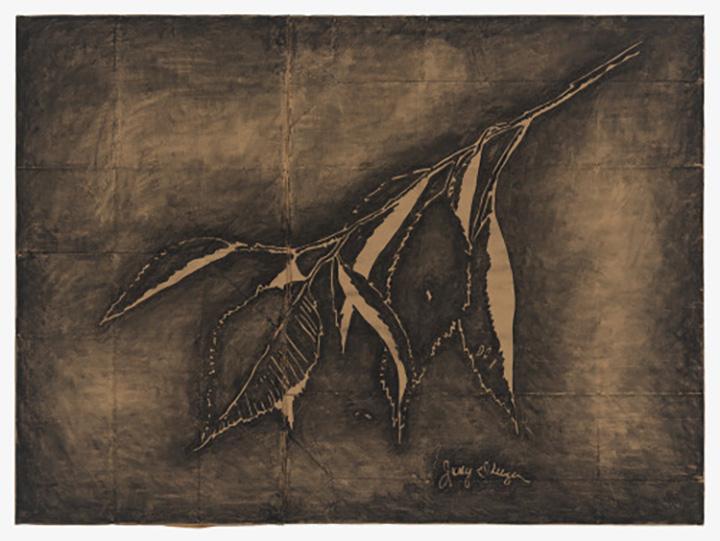
Robin Dluzen
Drawing of a Drawing My Mom Made (American Elm)
2016
Charcoal on lawn refuse bags and stretcher
36″ x 48″
You’ve recently curated with Stanislav Grezdo the exhibition Lions: Founding Years of UIMA in Chicago, at the Ukrainian Institute of Modern Art. The materials in this exhibition offer an important look into an area of Chicago’s art and cultural history. Were there any specific items that you found that should be more visible to a broader audience?
Many of the artworks in the exhibition have been shown quite a bit over the years at UIMA, but the items in the archive are being shown to the public for the first time. The selection of letters in “LIONS” is definitely the most revealing. Among these are a letter penned by UIMA artist Alexandra Kochman to a critic at the Sun Times, educating him on Ukrainian identity and denouncing the “russification” that abounded in his review that was written during the years when Ukraine was still a part of the Soviet Bloc, and a letter from the local KKK chapter threatening UIMA president Oleh Kowerko and the others associated with the museum.
These kinds of items are historical, yet so timely, shedding light on the fact that little has changed since the 1970s in terms of xenophobia and racism, and the sentiments in these letters illustrate the trials that all kinds of immigrants share, then and now.
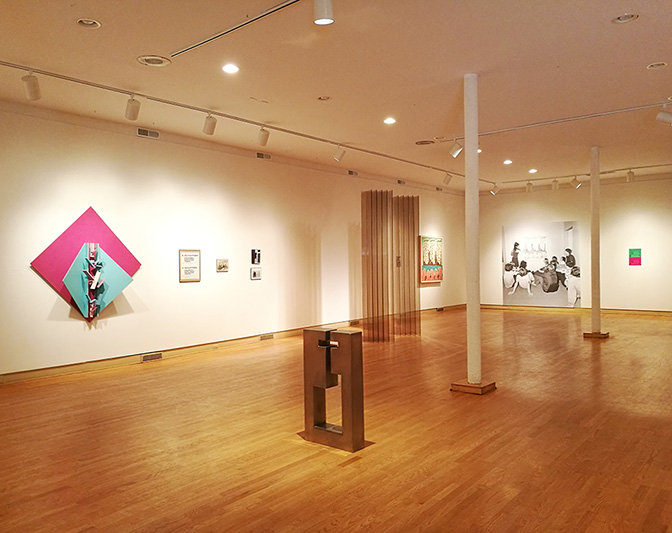
Installation view of LIONS: Founding Years of UIMA in Chicago, at Ukrainian Institute of Modern Art
August 3 – September 30, 2018
Co-curated by Robin Dluzen and Stanislav Grezdo.
A consistent focus in your studio practice is upon your family. For instance, in the series Drawing of a Drawing My Mom Made you revisit artworks produced by your mother. You’ve noted the influence and your connection to these works. I’m wandering how your translation of these materials extends the reading of the initial works? How does reinterpreting these materials comment on family in this time where the idea of family is being redefined?
The “Drawing of a Drawing My Mom Made” series came about when my mother retired from her 30-year career as a horticulturist. In addition to her work planting, cultivating and designing gardens, she also regularly created botanical drawings for her colleagues’ publications. I remember going to work with her in the summers, or when I left school with a stomach ache, and watching her work on these drawings at the lightbox.
When she cleaned out her desk a few years ago, it was a very powerful feeling to be holding these very pieces that I’d watched her work on when I was a preteen. In redrawing these, I enlarge the images, drawing around her lines and recreating her gestures –even her signature. They feel like collaborative pieces, even though her drawing and mine were created decades apart.
I’ve also done a few “Drawing of a Drawing My Dad Made” pieces, based on some sketches he’d done while telling me a story about working in an iron foundry in the mid-1970s when he was 19 years old.
I’m so similar to both of my parents in a lot of ways, and I credit my work ethic and my independent thinking to the examples they set when I was growing up. My parents’ identities, the work that they have done, and the way they live their lives, are very much a part of my own identity. I can hardly talk about myself without talking about them.
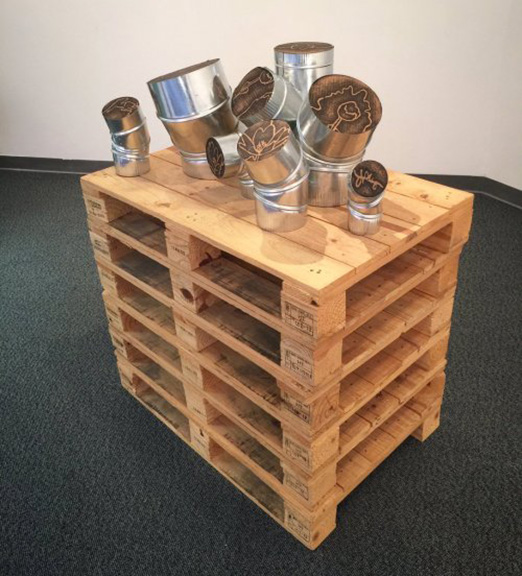
Robin Dluzen
Duct Elbow (with Drawings of Drawings My Mom Made)
2016
Cardboard, charcoal and aluminum duct elbows
Dimensions variable
In addition to the noted, you also regularly write criticism. Currently, you are a regular contributor covering art in Chicago for the L.A. based online zine Visual Art Source. Why do you think it is so difficult to maintain consistent art coverage in a city of this size? If you had the opportunity what would you do to remedy the situation?
From 2008-2011, I was Editor-In-Chief of Chicago Art Magazine, an online publication founded by our publisher Kathryn Born. Being privy to the financial operations of a magazine, I can tell you that this issue stems from Chicago’s self-consciousness of being perceived as a third-tier city behind LA and NY. Galleries and museums don’t want to spend their advertising dollars marketing to their own city; they’ll spend the big bucks on ads in national magazines like Art In America or Artforum, but not in local publications. Without that advertising income, it becomes impossible for Chicago-based publications to pay writers properly, and the quality and consistency of local art coverage wanes.
And you don’t need me to tell you about the prejudices about the Midwest held by the art world on the east coast, especially. In many ways, what we consider to be national art criticism is actually quite regional: it’s all New York.
I used to get upset about these kinds of things, but there’s quite a lot of freedom in flying under the radar, both as an artist and a critic, and freedom is more important to me than notoriety. You have to look on the bright side.
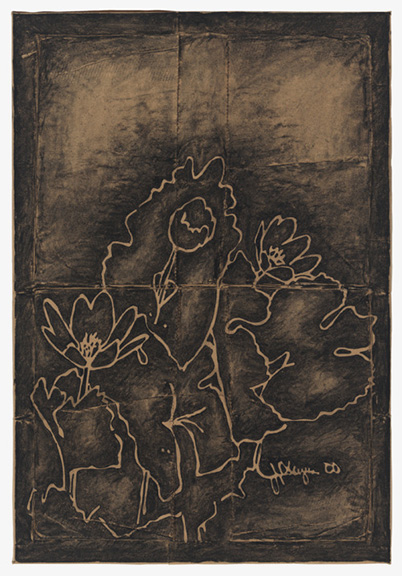
Robin Dluzen
Drawing of a Drawing My Mom Made (Bloodroot)
2016
Charcoal on lawn refuse bags and stretcher
26″ x 18″
Another area you are interested in is boxing. You teach this in Old Town at Hammer Fitness & Boxing. This interest stems from engagement with a fellow student at SAIC, Fang-Tze Hsu. In terms of teaching, has there been any specific shifts in the way you think about and produce your work?
Nothing about boxing or teaching boxing has changed the actual content of my work, thus far. However, the discipline of boxing is a lot like maintaining a studio practice, which is why I think both appeal to me. Whether you’re having a shitty day, you’re tired, you’re not feeling inspired, it doesn’t matter –you have to get to the gym and into the studio. Both art making and boxing are about constant work, logging the hours on a daily basis.

Robin Dluzen
Home Series (Face)
2014
Charcoal and enamel on lawn refuse bag
16″ x 12″
What do you value most in your varied visual art investigations?
I value content in art above all else. I occasionally write about formalists, but the kind of work I’m most passionate about says something boldly.
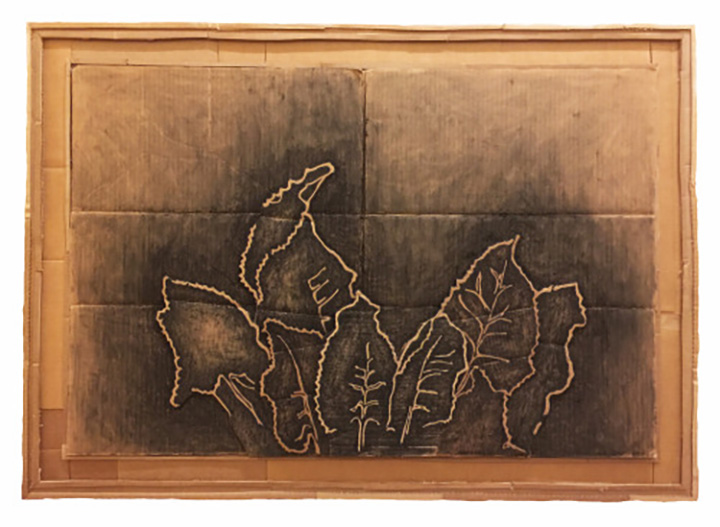
Robin Dluzen
Drawing of a Drawing my Mom Made (Prairie Dock)
2017
Charcoal and cardboard
33″ x 46″
With the exhibition, Lions: Founding Years of UIMA in Chicago, set, and a film about the founding opening at the Chopin theater on August 11th, where do you go from here? Are there any specific curatorial projects you are interested in? What do you have planned regarding your studio practice?
I’ve moved my studio several times over the past year, so I’m eager to get my rhythm back in terms of production. Now that the “LIONS” projects are completed, I can focus on a few more curatorial projects in the coming year and a half. One that will be at UIMA in 2019 is called “The New UnNatural,” co-curated with artist Mary Lou Zelazny, about female artists and the grotesque. Another has yet to be solidified, but will focus on local artists mastering unusual material.
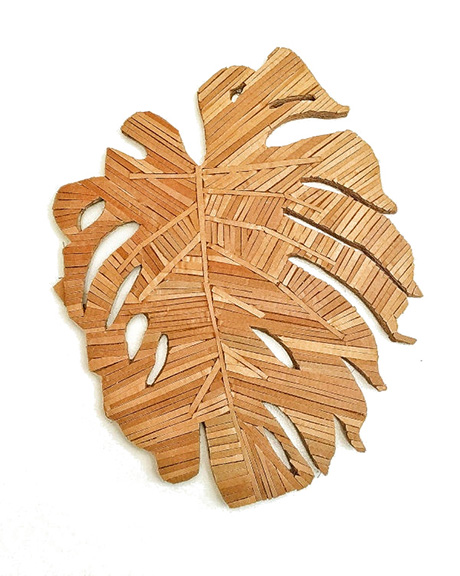
Robin Dluzen
Drawing of a Drawing My Mom Made (Swiss Cheese Plant IV)
2018
Cardboard
26″ x 20″
For additional information on the aesthetic, curatorial, and writing practice of Robin Dluzen, please visit:
Robin Dluzen – http://robindluzen.tumblr.com/
Twitter – https://twitter.com/RobinDluzen?ref_src=twsrc%5Egoogle%7Ctwcamp%5Eserp%7Ctwgr%5Eauthor
Voyage Chicago – http://voyagechicago.com/interview/meet-robin-dluzen/
art ltd. – http://artltdmag.com/author/robin-dluzen/
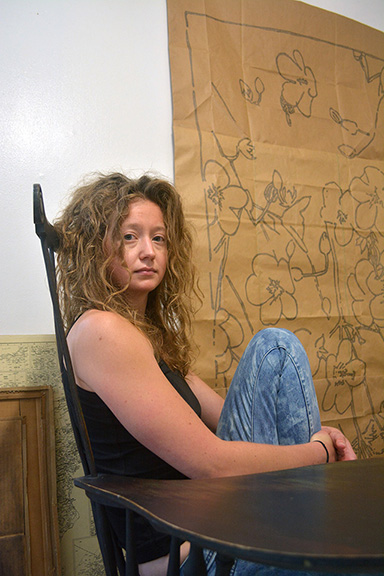
Robin Dluzen, artist, curator, and writer, Chicago, 2018
Artist interview and portrait by Chester Alamo-Costello


